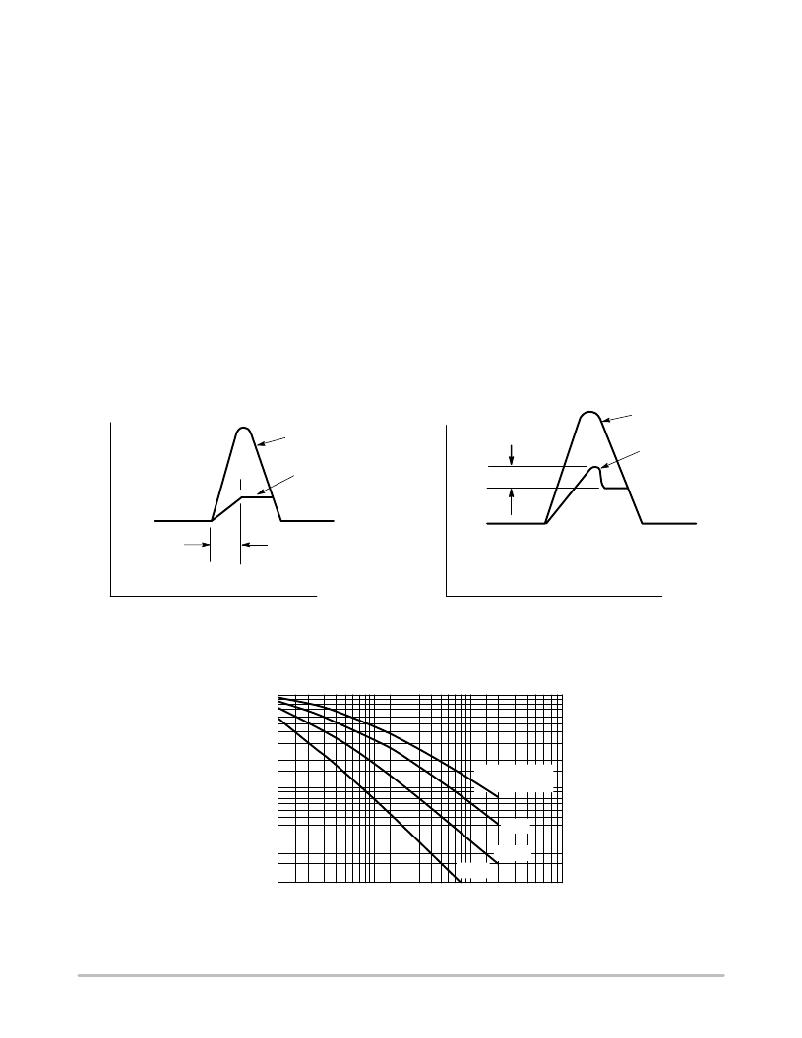- 您现在的位置:买卖IC网 > Sheet目录252 > SMBJ12AONT3G (ON Semiconductor)TVS ZENER UNIDIR 600W 12V SMB
�� �
�
SMBJ12AON�
�APPLICATION� NOTES�
�RESPONSE� TIME�
�In� most� applications,� the� transient� suppressor� device� is�
�placed� in� parallel� with� the� equipment� or� component� to� be�
�protected.� In� this� situation,� there� is� a� time� delay� associated�
�with� the� capacitance� of� the� device� and� an� overshoot�
�condition� associated� with� the� inductance� of� the� device� and�
�the� inductance� of� the� connection� method.� The� capacitive�
�effect� is� of� minor� importance� in� the� parallel� protection�
�scheme� because� it� only� produces� a� time� delay� in� the�
�transition� from� the� operating� voltage� to� the� clamp� voltage� as�
�shown� in� Figure� 3.�
�The� inductive� effects� in� the� device� are� due� to� actual�
�turn‐on� time� (time� required� for� the� device� to� go� from� zero�
�current� to� full� current)� and� lead� inductance.� This� inductive�
�effect� produces� an� overshoot� in� the� voltage� across� the�
�equipment� or� component� being� protected� as� shown� in�
�Figure� 4.� Minimizing� this� overshoot� is� very� important� in� the�
�application,� since� the� main� purpose� for� adding� a� transient�
�suppressor� is� to� clamp� voltage� spikes.� The� SMB� series� have�
�a� very� good� response� time,� typically� <� 1� ns� and� negligible�
�inductance.� However,� external� inductive� effects� could�
�produce� unacceptable� overshoot.� Proper� circuit� layout,�
�minimum� lead� lengths� and� placing� the� suppressor� device� as�
�close� as� possible� to� the� equipment� or� components� to� be�
�protected� will� minimize� this� overshoot.�
�Some� input� impedance� represented� by� Z� in� is� essential� to�
�prevent� overstress� of� the� protection� device.� This� impedance�
�should� be� as� high� as� possible,� without� restricting� the� circuit�
�operation.�
�DUTY� CYCLE� DERATING�
�If� the� duty� cycle� increases,� the� peak� power� must� be�
�reduced� as� indicated� by� the� curves� of� Figure� 5.� Average�
�power� must� be� derated� as� the� lead� or� ambient� temperature�
�rises� above� 25� °� C.� The� average� power� derating� curve�
�normally� given� on� data� sheets� may� be� normalized� and� used�
�for� this� purpose.�
�V�
�V� in� (TRANSIENT)�
�V�
�OVERSHOOT� DUE� TO�
�INDUCTIVE� EFFECTS�
�V� in� (TRANSIENT)�
�V� L�
�V� L�
�V� in�
�t� d�
�t� D� =� TIME� DELAY� DUE� TO� CAPACITIVE� EFFECT�
�Figure� 3.�
�t�
�Figure� 4.�
�t�
�1�
�0.7�
�0.5�
�0.3�
�0.2�
�PULSE� WIDTH�
�0.1�
�0.07�
�0.05�
�0.03�
�0.02�
�10� m� s�
�10� ms�
�1� ms�
�100� m� s�
�0.01�
�0.1� 0.2�
�0.5�
�1�
�2� 5� 10�
�20�
�50� 100�
�D,� DUTY� CYCLE� (%)�
�Figure� 5.� Typical� Derating� Factor� for� Duty� Cycle�
�http://onsemi.com�
�4�
�发布紧急采购,3分钟左右您将得到回复。
相关PDF资料
SMBJ15CA
DIODE TVS 15V 600W BI 5% SMD
SMBJ17A_SN00157
TVS UNIDIR 600W 17V SMB
SMBJ26CA
TVS BIDIRECT 600W 26V SMB
SMBJ30CA-E3/52
TVS BIDIRECT 600W 30V 5% SMB
SMBJ75CA-13
TVS BI-DIR 75V 600W SMB
SMBJ90-E3/52
TVS UNIDIRECT 600W 90V 10% SMB
SMCJ18CA
TVS BIDIRECT 1500W 18V SMC
SMCJ5V0CA
TVS BIDIRECT 1500W 5V SMC
相关代理商/技术参数
SMBJ12A-TP
功能描述:TVS 二极管 - 瞬态电压抑制器 12V 600 Watts RoHS:否 制造商:Vishay Semiconductors 极性:Bidirectional 工作电压: 击穿电压:58.9 V 钳位电压:77.4 V 峰值浪涌电流:38.8 A 系列: 封装 / 箱体:DO-214AB 最小工作温度:- 55 C 最大工作温度:+ 150 C
SMBJ12ATR
功能描述:TVS DIODE 12VWM 19.9VC SMB 制造商:smc diode solutions 系列:SMBJ 包装:剪切带(CT) 零件状态:有效 类型:齐纳 单向通道:1 双向通道:- 电压 - 反向关态(典型值):12V 电压 - 击穿(最小值):13.3V 电压 - 箝位(最大值)@ Ipp:19.9V 电流 - 峰值脉冲(10/1000μs):30.2A 功率 - 峰值脉冲:600W 电源线路保护:无 应用:通用 不同频率时的电容:- 工作温度:-55°C ~ 150°C(TJ) 安装类型:表面贴装 封装/外壳:DO-214AA,SMB 供应商器件封装:SMB(DO-214AA) 标准包装:1
SMBJ12A-TR
功能描述:TVS 二极管 - 瞬态电压抑制器 600W 12V Unidirect RoHS:否 制造商:Vishay Semiconductors 极性:Bidirectional 工作电压: 击穿电压:58.9 V 钳位电压:77.4 V 峰值浪涌电流:38.8 A 系列: 封装 / 箱体:DO-214AB 最小工作温度:- 55 C 最大工作温度:+ 150 C
SMBJ12AVCL
制造商:STMicroelectronics 功能描述:SMBJ12AVCL - Tape and Reel
SMBJ12C
功能描述:TVS 二极管 - 瞬态电压抑制器 12Vr 600W 30.2A 10% BiDirectional RoHS:否 制造商:Vishay Semiconductors 极性:Bidirectional 工作电压: 击穿电压:58.9 V 钳位电压:77.4 V 峰值浪涌电流:38.8 A 系列: 封装 / 箱体:DO-214AB 最小工作温度:- 55 C 最大工作温度:+ 150 C
SMBJ12C/1
功能描述:TVS 二极管 - 瞬态电压抑制器 600W 12V 10% Bidir RoHS:否 制造商:Vishay Semiconductors 极性:Bidirectional 工作电压: 击穿电压:58.9 V 钳位电压:77.4 V 峰值浪涌电流:38.8 A 系列: 封装 / 箱体:DO-214AB 最小工作温度:- 55 C 最大工作温度:+ 150 C
SMBJ12C/2
功能描述:TVS 二极管 - 瞬态电压抑制器 600W 12V 10% Bidir RoHS:否 制造商:Vishay Semiconductors 极性:Bidirectional 工作电压: 击穿电压:58.9 V 钳位电压:77.4 V 峰值浪涌电流:38.8 A 系列: 封装 / 箱体:DO-214AB 最小工作温度:- 55 C 最大工作温度:+ 150 C
SMBJ12C/2B
功能描述:TVS 二极管 - 瞬态电压抑制器 600W 12V 10% Bidir RoHS:否 制造商:Vishay Semiconductors 极性:Bidirectional 工作电压: 击穿电压:58.9 V 钳位电压:77.4 V 峰值浪涌电流:38.8 A 系列: 封装 / 箱体:DO-214AB 最小工作温度:- 55 C 最大工作温度:+ 150 C